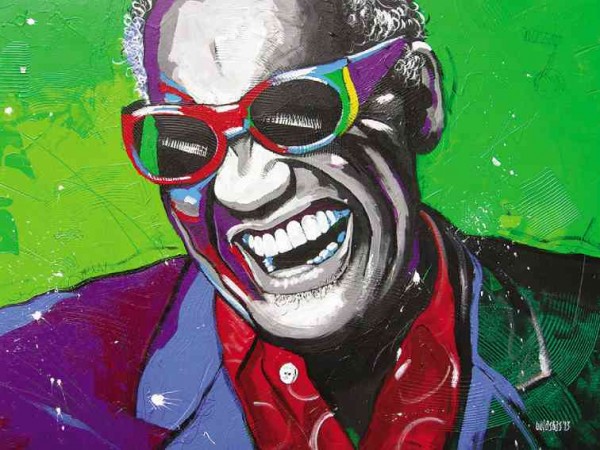
Combining admiration and aspiration, Jun Balasbas presents stylized portraits of popular figures in “Stars in My Sleep,” ongoing in Gallery Big at the LRI Design Plaza in Makati.
Balasbas has done well to include his neon-green-faced rendition of Albert Einstein’s famous tongue-exposing pose, as it seems to be the visual transcription of the genius physicist’s’ declaration that “imagination is more important than knowledge.” It’s a statement that likewise seems to refer to the autodidact painter’s artistic nascence.
Without formal schooling in the fine arts and multimedia applications, Balasbas has pursued his childhood dream of becoming a painter since he started working as an illustrator for a greeting-card company.
From drawing by hand in the mid-’90s to learning to use computer software for graphic illustration and finally painting, he has sought to improve his artistic output, fueled by a passion for creation.
Affinity
Nightly ruminations on the lives of his personal icons also had him taking stock of his art. Concluding that his body of works had been fashioned from his day job as an illustrator, he decided to challenge himself to take a “step forward” by painting the images of the personalities who had inspired him.
The pieces in the series have the subjects’ first names as titles, a detail the artist says speaks of the affinity he has with each personality.
This bond, he believes, is one with which many would empathize. Just as he has, multitudes have grown up learning about them in class and hearing or watching those still alive as their stories of excellence unfold.
People revere them, wanting to emulate their work ethic, and perhaps achieve at least a fraction of their greatness and fame; this has resulted in cult followings.
For many, these “stars” have left marks on the collective psyche such that Balasbas says they are somehow part of each one of us.
With acrylic, pencil, ink, and his own brand of fluorescent flourishes, Balasbas transports on canvas celebrities’ familiar pictures. In the process, he carries out his intent to display skill other than his usual output reminiscent of graphic work.
The completion of each piece also pushed him to aspire for a surge in his art-making in the same way that the icons blazed trails in their respective fields.
Pink noise
Science is covered by the fantastic blue-and-white-haired, many-colored face of “Albert.”
Apart from the Einstein rendering, “Elvis” Presley is also given a notable, brightly psychedelic tribute. It may come as a surprise but the King of Rock and Roll comes with a bubble-gum-pink appearance, which is apt. It brings to mind pink noise and the identification of sound patterns by color.
Pink noise is said to “mask low-frequency background sound, potentially helping to increase productivity and concentration”—apparently a benefit the painter had absorbed.
An example of naturally occurring pink noise is the human heartbeat, which, again, fits the depiction, for it can call to mind the pumping beats of Elvis’ “bebop-a-loolahs” or his legions of fans’ racing pulses.
Balasbas’ heart rate used to rise at the thought of having to capture exact likenesses. Not having had tutelage in drawing from life, his trepidation is understandable. As such, going into the direction of portraiture was also stepping out of his comfort zone.
However, the thirst to showcase his latent abilities won over, and he discovered that he could begin to move away from his past illustrative style by fusing emulative tributes to his Pop Art models Lichtenstein and Warhol while maintaining his penchant for bright colors.
His choice of neon as a tool for tweaking images is fitting because etymology equates the word with “new,” and very well highlights the unveiling of his evolved talent.